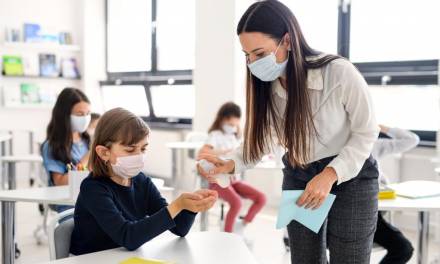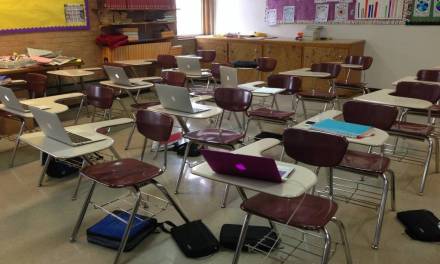The Government guidance on school reopening states: “The overarching principle to apply is reducing the number of contacts between children and staff. This can be achieved through keeping groups separate (in ‘bubbles’) and through maintaining the distance between individuals.”
The reason for this is to keep teachers and pupils safe by minimising the number of people they come into contact with.
This blog post explains teachers’ safety when rotating and students remain inside a fixed classroom.
Government guidelines on minimising contact
The Government’s guidance states:
Consistent groups reduce the risk of transmission by limiting the number of pupils and staff in contact with each other to only those within the group. They have been used in schools in the summer term in recognition that children, especially the youngest children, cannot socially distance from staff or from each other and this provides an additional protective measure. Maintaining distinct groups or ‘bubbles’ that do not mix makes it quicker and easier in the event of a positive case to identify those who may need to self-isolate and keep that number as small as possible.
The guidance then states that maintaining consistent groups remains important, “but given the decrease in the prevalence of coronavirus (Covid-19) and the resumption of the full range of curriculum subjects, schools may need to change the emphasis on bubbles within their system of conrols and increase the size of these groups.”
In secondary schools, particularly in the older age groups at key stage 4 and key stage 5, the groups are likely to need to be the size of a year group to enable schools to deliver the full range of curriculum subjects and students to receive specialist teaching. If this can be achieved with small groups, they are recommended. At primary school and in the younger years at secondary (key stage 3), schools may be able to implement small groups the size of a full class. If that can be achieved, it is recommended, as this will help to reduce the number of people who could be asked to isolate should someone in the group become ill with coronavirus (Covid-19).
Schools should assess their circumstances and if class-sized groups are not compatible with offering a full range of subjects or managing the practical logistics within and around the school, they can look to implement year group sized ‘bubbles’. Whatever the size of the group , they should be kept apart from other groups where possible and older children should be encouraged to keep their distance within groups. Schools with the capability to do it should take steps to limit interaction, sharing of rooms and social spaces between groups as much as possible. When using larger groups the other measures from the system of controls become even more important, to minimise transmission risks and to minimise the numbers of pupils and staff who may need to self-isolate. We recognise that younger children will not be able to maintain social distancing and it is acceptable for them not to distance within their group.
Teachers’ safety: what is the guidance?
When it comes to staff, guidance says:
All teachers and other staff can operate across different classes and year groups in order to facilitate the delivery of the school timetable. This will be particularly important for secondary schools. Where staff need to move between classes and year groups, they should try and keep their distance from pupils and other staff as much as they can, ideally 2 metres from other adults. Again, we recognise this is not likely to be possible with younger children and teachers in primary schools can still work across groups if that is needed to enable a full educational offer.
Challenges of minimising contact
The implementation of these guidelines poses both educational and logistical challenges.
Among these challenges are regular cleaning demands and practicality of social distancing in shared spaces. These include:
- Playgrounds
- Boarding houses
- Dining halls
- Toilets
- The provision of specialist teaching
This is a particular case in secondary schools.
Teaching SEND students
Some teachers will need to support pupils with SEND (whether with education, health and care plans or on SEN support). These students need specific help and preparations.
EDClass can help students with dyslexia and other needs. Our online platform means students can learn at their own pace as well as via a targeted learning pathway tailored to their needs. These lessons (which include live and recorded teaching) takes place online, meaning fewer students in the classroom and greater protection for students and staff.
Teachers’ safety: make decisions to meet teaching objectives
The guidance also states, on the subject of performance management, to make decisions such as “a decision to restrict pupil attendance at schools” where without doing so has “an impact on the ability of the teacher to meet fully their objectives”. And in doing so, performance management reviews and appraisals will not be penalised.
It is likely that a return post-lockdown will see a negative change in behaviour, as students have been away from school expectations and routines. This could result in increase numbers of students in isolation and those temporarily or permanently excluded.
EDClass was originally set up to support these students – and re-engage them in education. So by placing them on the platform you can improve attainment and protect the wellbeing of staff and students.
Safeguarding is a major feature of the system, with measures in place including alert mechanisms, instant chat, highly trained teachers and staff and eyes-on learning to identify any issues. Any concerns, the school will be immediately contacted by our safeguarding lead.
Click here for a free demonstration of our system.
Alternatively click here for more information on how we support teachers’ safety.
To find out more and have your questions answered by our team, call 01909 568338.









